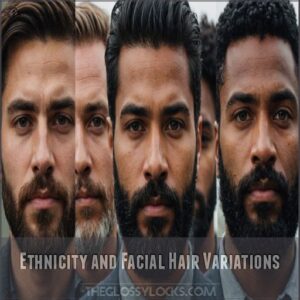This site is supported by our readers. We may earn a commission, at no cost to you, if you purchase through links.
 Growing a full beard takes patience, but you’ll be sporting a rugged mane before you know it.
Growing a full beard takes patience, but you’ll be sporting a rugged mane before you know it.
On average, it takes 2-4 months to grow a full beard.
You’ll see stubble within a week, noticeable growth in 2-4 weeks, and significant coverage by 2 months.
Asian men’s beard growth rates vary due to lower levels of dihydrotestosterone (DHT), but remember, everyone’s unique beard growth potential plays a role, and everyone’s facial hair grows at different rates.
Genetics, age, and hormones play key roles in your beard’s journey.
Some lucky guys can rock a full beard in 6 weeks, while others might need 6 months.
Don’t get discouraged if your growth seems slow – Rome wasn’t built in a day, and neither was Hemingway’s beard.
Stick with it, and you’ll discover the secrets to faster, fuller growth.
Table Of Contents
- Key Takeaways
- Beard Growth Timeline
- Factors Affecting Beard Growth
- Beard Growth Phases Explained
- Strategies for Optimal Beard Growth
- Achieving a Full Beard Look
- Frequently Asked Questions (FAQs)
- How long does it take to get a full beard?
- Does castor oil help with the growth of a beard?
- How fast does a beard grow?
- When can a man grow a full beard?
- How long does it take to grow a short beard?
- When does beard growth start?
- How Long It Takes to Grow A Beard as A teenager?
- Can certain medications affect beard growth speed?
- How does facial hair color impact growth visibility?
- Do beard-growth supplements actually work?
- Is trimming necessary during the initial growth phase?
- Can facial exercises stimulate faster beard growth?
- Conclusion
Key Takeaways
- You’ll typically grow a full beard in 2-4 months, but it varies based on your genetics, age, and hormones.
- Your beard growth follows distinct phases: stubble in a week, noticeable growth in 2-4 weeks, and significant coverage by 2 months.
- You can optimize your beard growth by maintaining a balanced diet, managing stress, and following proper beard care routines.
- You’ll need patience during the growth process, as beard development is unique to each individual and may include patchy or uneven stages.
Beard Growth Timeline
You’re about to start on a hairy journey that’ll transform your face over time.
From stubble to a full-fledged beard, you’ll witness distinct stages of growth.
These stages typically span two to six months.
Initial Stubble Growth (0-7 Days)
As you begin your beard journey, the first week is like planting seeds of masculinity.
You’ll notice stubble growth speed varies, with some areas sprouting faster than others.
Embrace the itch; it’s a sign of progress.
Consider using a beard oil for growth to help promote healthy growth.
Keep your skin clean and moisturized to ease discomfort.
Visible Hair Growth Patterns (14-28 Days)
Your stubble’s grown into something more substantial now.
Between days 14-28, you’ll start noticing visible hair growth patterns. It’s like your face is plotting a beard map. Some areas might sprout like weeds, while others lag behind.
Beard bald spots, often caused by conditions like alopecia areata treatments, can make growing a full beard challenging. Don’t panic if you see patchy spots or uneven growth – it’s normal. Your beard’s just flexing its personality. Keep nurturing it, and soon you’ll be rocking that rugged look you’re after.
Significant Beard Growth (28-56 Days)
The real magic happens between days 28 and 56.
You’ll notice significant beard growth, revealing your full beard potential.
Patchy spots might start filling in, but don’t sweat it if some areas lag behind.
It’s prime time to step up your beard care game.
Invest in quality beard oil to tame those whiskers and keep your skin happy.
Remember, every beard’s journey is unique – embrace yours!
Trimming and Shaping (56+ Days)
Now you’re in the driver’s seat of your beard journey!
It’s time to sculpt that facial masterpiece.
Grab your trimmer and let’s get to work.
Here’s your beard-shaping roadmap:
- Define your neckline for a clean look
- Trim stray hairs to maintain a neat appearance
- Shape your cheek line to complement your face
Remember, a well-groomed beard is your secret weapon.
It’s not just hair—it’s your signature style.
Factors Affecting Beard Growth
Your beard’s growth journey isn’t just about time; it’s influenced by a mix of factors unique to you.
From your age and genes to your lifestyle and health, understanding these elements can help you set realistic expectations for your facial hair adventure.
Age and Hormones
With age, your beard becomes your power play.
Puberty kicks off the facial hair growth game, but it’s a slow burn.
As you hit your 20s and 30s, testosterone levels peak, turbocharging your beard growth.
But watch out for hormonal imbalances – they can throw a wrench in your facial fuzz plans.
Remember, everyone’s growth patterns are unique, so don’t sweat it if your beard’s taking its sweet time.
Genetics and Family Traits
Beyond age and hormones, your beard’s destiny is written in your DNA.
Ever wondered why you can’t grow a full beard like your dad? Blame (or thank) your genes! They dictate everything from hair texture to growth patterns.
If patchy beards run in your family, you might face the same challenge.
But don’t lose hope – your unique genetic blueprint could surprise you with unexpected beard prowess.
Ethnicity and Facial Hair Variations
Ethnicity plays a fascinating role in your beard growth journey.
Cultural perceptions and genetics intertwine to create unique facial hair patterns.
You’ll notice:
- Hair texture differences across ethnicities
- Varied beard growth rates and density
- Distinct facial hair distribution patterns
- Diverse skincare needs for best growth
Embrace your genetic blueprint!
Tailor your beard care routine to your specific needs.
Remember, whether you’re rocking a full beard or a patchy stubble, it’s all about owning your look with confidence.
Medical Conditions and Beard Growth
Medical conditions can throw a wrench in your beard-growing plans.
Alopecia barbae, for instance, might leave you with patchy spots that feel like crop circles on your face.
Thyroid disorders and hormonal imbalances can also slow your facial fuzz factory.
But don’t throw in the towel just yet!
Hair loss treatments and even beard transplants can help you conquer these hurdles.
Remember, a full beard isn’t just about genetics – your overall health plays a starring role too.
Beard Growth Phases Explained
Your beard’s journey follows three distinct phases: anagen (active growth), catagen (transition), and telogen (rest). Understanding how beards symbolize dominance and masculinity, as seen in the psychology of beard intimidation is a beard intimidating, can also impact your approach to growing a full beard. Understanding these stages can help you set realistic expectations and nurture your facial hair effectively.
Anagen Phase (Active Growth)
Now that you’re aware of the factors influencing your beard, such as genetics and hormone levels, which can significantly impact beard thickness as explained in beard thickness factors, let’s talk about the powerhouse behind your facial hair growth: the anagen phase.
It’s like your beard’s growth spurt, where hair cells divide faster than a cat chasing a laser pointer.
During this phase, your beard’s potential truly shines.
Understanding the overall hair growth cycle stages explained is important to grasping the anagen
Catagen Phase (Transitional Phase)
After the growth spurt, your beard hits the brakes.
This catagen phase is like your facial hair’s pit stop.
It’s short, lasting only a couple of weeks.
During this time, your hair follicles shrink and detach from their blood supply.
Don’t panic if your beard seems to stall – it’s just gearing up for the next round.
Patience is key here, folks!
Telogen Phase (Resting Phase)
Your beard’s taking a breather in the telogen phase.
It’s like your facial hair’s hitting the snooze button for about 2-4 months.
During this time, you might notice some shedding – don’t panic, it’s all part of the beard growth cycle.
To support your beard’s growth, consider taking Beard Growth Vitamins to help
Strategies for Optimal Beard Growth
You can boost your beard growth with a few simple strategies. From eating right to managing stress, we’ll show you how to nurture your facial hair for the best results.
Balanced Diet and Nutrition
Fueling your beard’s growth isn’t just about waiting it out.
You’ve got to feed that facial forest!
Including essential nutrients for beard growth like biotin, vitamin C, and zinc, as well as beard growth vitamins, can turbocharge your journey to bearded glory. A balanced diet packed with vitamins for beard growth can turbocharge your journey to bearded glory.
You can also look into biotin supplements to help strengthen your hair.
Let’s break down the nutritional superstars that’ll have you stroking a lush mane in no time:
| Nutrient | Beard-Boosting Benefits |
|---|---|
| Zinc | Promotes hair growth |
| Biotin | Strengthens hair |
| Vitamin D | Stimulates new follicles |
Remember, you’re what you eat – so chow down on these beard-friendly foods and watch your whiskers thrive!
Lifestyle Habits and Stress Management
Beard growth isn’t just about what you eat – it’s how you live.
Stress can put the brakes on your facial fuzz, so take charge with some zen habits.
Get your beauty sleep (7-8 hours), break a sweat regularly, and chill out with meditation or mindfulness.
These power moves boost testosterone levels, giving your beard the green light to grow.
Remember, a stress-free you equals a fuller beard, too!
Beard Care and Maintenance
While growing a majestic mane, proper care is your secret weapon.
Tame that wild beast with these power moves:
- Apply beard oil daily to moisturize and promote healthy growth
- Use a beard trimmer to shape and maintain your desired style
- Wash regularly with beard-specific products to keep it clean and fresh
Master these techniques, and you’ll be sporting a beard that commands respect and turns heads. It’s all about control, persistence, and the right tools.
Supplements and Medical Interventions
For those seeking to maximize their beard’s full potential, supplements and medical interventions can be game-changers.
You’ve got options to turbocharge your facial fuzz.
Let’s break down the heavy hitters:
You might find that incorporating certain vitamins and minerals, like biotin and zinc, into your diet can help support healthy beard growth.
| Intervention | Benefit | Caution |
|---|---|---|
| Testosterone therapy | Boosts growth | Doctor’s supervision required |
| Beard supplements | Nourishes follicles | Results vary |
| DHT blockers | Prevents hair loss | May affect other body hair |
| Derma roller | Stimulates circulation | Use gently to avoid irritation |
Remember, what works for one mightn’t work for all.
Consult a pro before diving in.
Achieving a Full Beard Look
You’ve grown your beard, but achieving that full look takes more than just waiting.
Let’s explore how to work with your unique growth pattern and use styling tricks to create the appearance of a fuller, more impressive beard.
Patience and Managing Expectations
On your beard growth journey, patience isn’t just a virtue—it’s your secret weapon.
You’re not just growing facial hair; you’re cultivating mastery over your appearance.
Set realistic goals and embrace the process, imperfections and all.
Remember:
- Rome wasn’t built in a day, and neither is a full beard
- Your genetics are your beard’s blueprint—work with what you’ve got
- Age and ethnicity play their parts—respect your unique timeline
- Consistency is key—stick to your routine and watch the magic unfold
Beard Growth Realities and Variations
You’ve started your beard journey, but the road to a full mane isn’t always smooth.
Beard growth patterns vary wildly, and patchy beards are more common than you’d think.
Your genetics and ethnicity play a big role in beard thickness and density.
Some guys sport full beards in weeks, while others need months.
Don’t sweat it if your growth is slow – patience is key in mastering your facial hair game.
Maintenance Tips and Styling Techniques
Mastering beard maintenance is key to achieving that full, rugged look.
Incorporate a solid beard care routine: wash with beard-specific products, apply beard oil daily for hydration, and use beard balm for styling.
Invest in quality beard grooming tools like trimmers and combs.
Experiment with different beard shaping styles to find your signature look.
Remember, a well-groomed beard speaks volumes about your attention to detail and personal style.
Frequently Asked Questions (FAQs)
How long does it take to get a full beard?
Growing a full beard takes patience.
You’ll see stubble in a week, but a lush, full beard?
That’s a two to six-month journey.
Your genetics and hormones play a big role, so everyone’s timeline’s different.
Does castor oil help with the growth of a beard?
Castor oil’s effectiveness for beard growth isn’t scientifically proven, but it may help.
It’s rich in ricinoleic acid, which could boost circulation and nourish follicles.
Try it out, but don’t expect miracles.
Patience and genetics play bigger roles.
How fast does a beard grow?
Your beard’s on a mission, growing about 5 inches monthly.
That’s roughly half a millimeter daily – slower than watching paint dry, but faster than you’d think!
Patience is key in this hairy journey.
When can a man grow a full beard?
Most men can grow a full beard between 18 and
You’ll notice significant growth around 28 days.
It’s a journey that varies for everyone, so don’t sweat it if you’re a late bloomer.
Patience is key!
How long does it take to grow a short beard?
Did you know beards grow about 5 inches monthly?
You’ll see a short beard in 4-6 weeks.
Keep it trim, use beard oil, and embrace the stubble stage.
It’s a quick journey to rugged charm!
When does beard growth start?
Beard growth typically kicks off during puberty, around age 13-
You’ll notice peach fuzz evolving into stubble.
However, full beard potential often doesn’t hit until your early 20s.
Genetics play a big role in your facial hair journey.
How Long It Takes to Grow A Beard as A teenager?
Like watching paint dry, growing a beard as a teen takes patience.
You’ll start seeing stubble around 16-18, but a full beard? That’s a 2-6 month journey.
Genetics play a big role, so don’t sweat it if it’s slow.
Can certain medications affect beard growth speed?
Absolutely, certain meds can put the brakes on your beard growth.
Steroids, chemotherapy drugs, and some hair loss treatments, like those using Tricho-Prime Technology for targeted hair regrowth treatments, might slow things down.
It’s like your facial hair’s hit a speed bump.
Always chat with your doc about potential side effects.
How does facial hair color impact growth visibility?
Your facial follicles’ hue plays a sneaky game with perception.
Lighter shades like blonde or red might seem slower to grow, while darker colors appear fuller faster.
It’s all about contrast against your skin tone, not actual growth speed.
Do beard-growth supplements actually work?
Beard-growth supplements claim to boost growth, but evidence is limited.
While some vitamins may support hair health, they’re not magic beans.
You’re better off focusing on a balanced diet, proper grooming, and patience for that epic beard.
Is trimming necessary during the initial growth phase?
Like tending a garden, trimming isn’t essential early on.
Let your beard grow wild for 4-6 weeks.
You’ll get a clearer picture of your growth pattern.
Then, shape it to your liking for a more polished look.
Can facial exercises stimulate faster beard growth?
Sorry to burst your bubble, but facial exercises don’t boost beard growth.
Genetics and hormones are the real MVPs here.
Instead, focus on a healthy lifestyle, proper grooming, and patience.
Your beard’s got its own timeline, so embrace the journey!
Conclusion
Growing a full beard isn’t just a waiting game; it’s a journey of self-discovery.
While it typically takes 2-4 months to achieve that rugged look, remember that everyone’s facial hair march is unique.
Genetics, age, and lifestyle all play their part in answering "how long does it take to grow a full beard?"
Embrace the process, stay patient, and nurture your beard with proper care.
Whether you’re a quick grower or a slow and steady type, your perfect beard is worth the wait.
Rock it with confidence!














